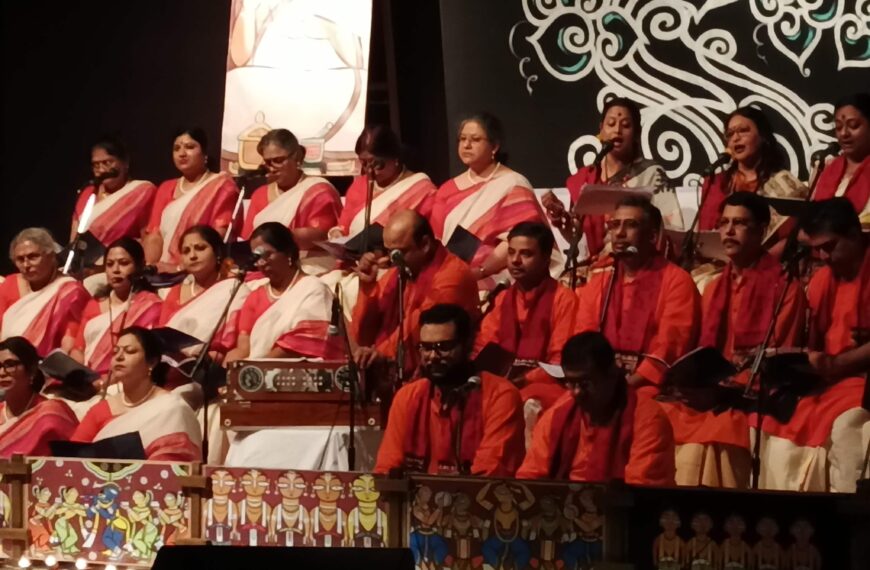Ruchira explores Rabindranath Tagore’s appreciation for summer in his poetry, highlighting its beauty and power, and Tagore’s use of long robes in the heat. An exclusive for Different Truths.

Over the past few weeks, the major parts of the country have found themselves in the throes of a severe heat wave that shows no signs of relenting. Sweaty and thirsty hordes are left fervently praying for a reprieve… But alas! The azure skies, with not even the tiniest speck of cloud, and violent gusts of dusty, hot winds sum up each day. Save the individuals who are busy in ostensible occupations, the daylight hours make one languid, listless and slumberous. To divert your mind, you need to focus on something close to your heart.
As the much-hyped Robi Mash (Tagore’s month-long birth anniversary celebrations and observance) draws to a close, it is heartening to realise how the versatile Bard brought forth a fantastic anthology of lyrics dedicated to nature Prakriti) and the cycle of Indian seasons (Ritu Parjay).
Due to its coastal and tropical location, Bengal (as a composite unit, the barbed wires notwithstanding) is one of the subcontinent’s hottest regions. Amazingly, Tagore possessed the energy and enthusiasm to pen lyrics on the harshest and most formidable season, summer (Grishma).
Indeed, summer appears to have been a key factor in Tagore’s life. Maharshi Debendranath Tagore, his father, had acquired the vast tract where Vishwa Bharati University stands now, while Rabi was still quite young. Incidentally, the area in question, Bolpur, is in Birbhum, which figures amongst the driest parts of today’s West Bengal.
The poet also had a close brush with summer heat while he was sojourning in the numerous Tagore family estates scattered over modern-day Bangladesh. One of his familiar ditties “Madhya diner bijan batayane” (a summer noon on a patio) ushers in a mood of melancholy and nostalgia together; there is little else that one can do while the torrid heat rages on.
Upon studying Tagore’s works closely, one is bound to discover that nowhere in his vast repertoire of poetry does he vilify the season in any manner. On the contrary, his powerful imagination blended with an element of fantasy, portrays Summer as Bhairav and Rudra, two of the several avatars of Lord Shiva: fiery, aggressive, ruthless yet benevolent compassionate and saintly. It must be admitted that these emanations of the Lord create havoc, ravaging loveliness and beauty that is characteristic of spring. But in the process, the duo cleanses our Earth of all the dross. Filth, malice and pestilence are reduced to cinders by overpowering heat. An oft-quoted line “Ghuche jaak glani muchhe jaak jora, agni snane shuchi hok dhora.” comes to mind.
Another immensely popular lyric reads, “Daarun agni baaney Hriday trishay haane re,” (the sky is spewing arrows of fire…the heart is seething with pangs of thirst)
But not all is lost. The final lines are replete with great optimism and hope. “Jani jhanjhar beshe…dibe dekha tumi eshe.” (Assuming the form of a thunderstorm, Thou will appear and the inferno will douse).
Whenever the subject of Tagore and his oeuvres comes up with a question which might appear a tad weird: crosses my mind. In most of his photographs, the Bard is seen perpetually clad in long robes which, even at a cursory glance, appear to be highly unsuitable for the notorious Bengal summer. Also, consider the fact that even in most of the affluent homes of that era, air coolers and air conditioners were unheard of.
Granted, the family’s Jorasanko home was a stone’s throw away. from the river flowing by. Also in that bygone era, the metropolis had larger open spaces and much less congestion. In contrast, the poet’s Santiniketan ‘stay’ must have been a greater ordeal, nightmarish. Nevertheless, he did survive at both places with a never-say-die spirit. Which underlines the level of human endurance one may possess? And rightfully so, for Tagore was no ordinary mortal.
Picture design by Anumita Roy
Video from YouTube






 By
By
 By
By

 By
By